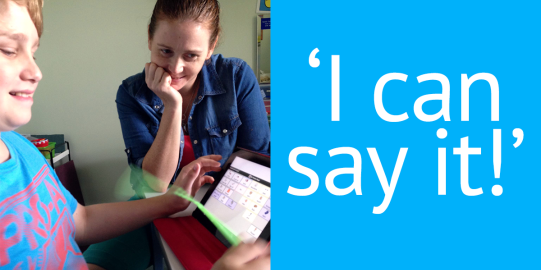When starting the Augmentative and Alternative Communication (AAC) journey, it is very important to personalize the system so it suits the communicators preferences and individual needs. Out of the box, a communication device or app may not do or say exactly what we want it to.
Personalizing AAC is crucial for success of the system. This is a team process, where everyone can contribute something in the set up. Remember that the team may include siblings, peers, and classmates. Most importantly, it should also include the AAC user. Often, the AAC user can develop a sense of ownership by participating in personalizing their AAC system. This helps contribute to both early acceptance and long-term success of the system.
This article will outline considerations for this personalization. This includes ways to personalize fringe vocabulary, and ways to customize the AAC system: for voice, appearance and access.
Personalize fringe vocabulary
If we have chosen a balanced AAC system, the user already has access to core and fringe words organized into categories or folders. Are the user’s most personally important words in the system? Are they easy to find?
Identify the words that are highly motivating and of high interest. Make sure these words are in the system. As we add words, we should try to put them into logical folders and locations that will make sense for anyone to find. New people in the AAC user's life should be able to guess where they might be.
Some common examples of vocabulary to personalize include:
- About Me folder: Make sure that buttons giving information like the user's name and age are filled in with the correct and current information.
- People folder: include family, friends and other important people in the AAC user’s life. You can take photos of these people and add them to the buttons.
- Places folder: include regular and favorite places that the AAC user goes.
- Foods: make sure to put foods the user frequently eats on the first pages of the folders, where they are easy to find.
- Activities: include YouTube channels, favorite websites, books, movies, games, toys, music, and any other activities you think the AAC user will want to talk about.
- Preprogrammed phrases and sentences: work with the AAC user to write and save phrases or sentences that may be said often.
Many of these words will be nouns, specific verbs, or specific adjectives. These should be added alongside core words on the AAC system. We can combine these fringe words with core words to make many different messages. For example, if we add a friend’s name “Jessie” to the people page, we can say sentences like:
- “I like Jessie”,
- “I go with Jessie to __”,
- “Jessie is good”, “Jessie makes __”,
- “Can Jessie help me?”,
- “Not Jessie”, etc.
If you are using Proloquo2Go, you will notice that most folders divide vocabulary between two pages. This is the VocaPriority™ feature. You should move buttons to the first or second page level based on frequency of use. This way, you can make the most needed vocabulary quickest to access.
Remember, we do not always need to add every word we encounter to the vocabulary. If we are in a situation where the AAC user needs a new word, should it be added to the system? Is the AAC user likely to use that word again? Perhaps we can first search the vocabulary for the word. If the word is not likely to be used again, it may be a good opportunity to model spelling it on the keyboard. We can speak the word from the keyboard without having to add it to the vocabulary.
Personalizing PODD
If you are using the PODD communication system, with the simPODD app, then you will also want set up your AAC. Read Erin's tips on how to customize your simPODD. This includes valuable reminders to help us make a start and keep track of what vocabulary might need to be added over time.
Personalize the AAC system
Out of the box, an AAC system will have certain default settings. We will often need to change some settings to suit the individual’s needs and preferences. One of the first steps was selecting the grid size with the right number of buttons per page. But we can also personalize 3 key settings: the system’s voice, appearance and access.
1. Personalizing voice
Out of the box, an AAC system will have certain default settings. Listen to the different voices offered in the AAC system, and choose one that matches by gender, age and accent. It is essential to involve the user in this choice. They are likely to have a preference as to which voice they want to use. Help them to choose a different voice. Or even change how the voice sounds.
Sometimes the voice we choose does not pronounce certain words correctly. In Proloquo2Go, we can change a word’s pronunciation in the settings.
2. Personalizing appearance
We may wish to adjust the AAC system’s appearance. This may include changing the toolbar size or the background and button colors. We can also use a different font or turn off some of the symbols on buttons. There are many ways to customize the appearance of the AAC system. Again, the team and AAC user should be involved in this process.
3. Personalizing access
Some AAC users may have visual or physical difficulties which affect their access to the system. Explore the different access settings within the AAC system, so that it can support their needs.
If you are using Proloquo2Go, you can read more articles on customizing for alternative access.
Ongoing changes
Remember that we can change and customize the AAC system at any time. We will often need to add words to an AAC user’s system. We may need to change how the system looks and behaves. Check in with the team and the AAC user regularly to see what changes are needed. Consider different environments and activities so vocabulary can be added as needed for increased participation.
Remember to keep adding vocabulary as needed, so the user can talk about new people, places, and interests, and share important experiences in their life. Always make sure that the vocabulary available provides room for language growth.
Save all changes
Save customizations by backing up your AAC system. Check your back up settings regularly to make sure everything is as you expect. Backing up in Proloquo2Go is easy!
The next step
Personalizing the AAC system is an important, ongoing step in the AAC process. Another step to setting up for AAC is to make AAC always available.
Links & References
- Go to our Help and Support section for specific ways to personalise and customise Proloquo2Go.
- Zangari, Carole. (2015). What Should I Program on the AAC Device?. [Blog post]
- Zangari, Carole. (2013). Thoughts on Involving Our Clients in AAC Vocabulary Selection. [Blog post]




